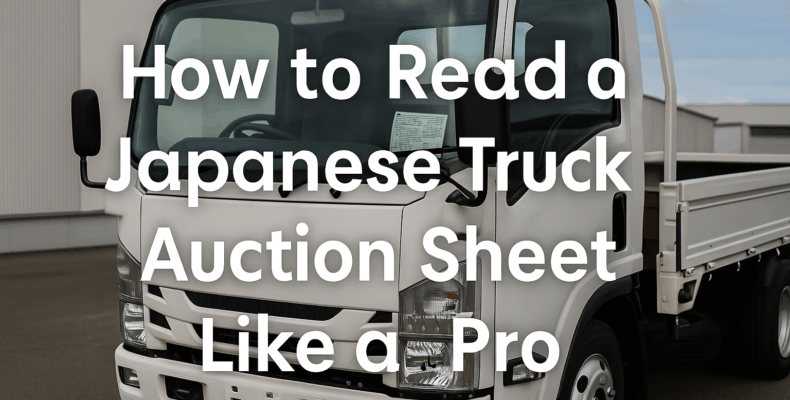If you’re looking to import a Japanese used truck, chances are you’ll come across something called an auction inspection sheet. This document gives you key information about the truck’s condition—straight from the auction house. However, many global buyers find these sheets confusing, especially since they’re usually written in Japanese with cryptic symbols.
Understanding this sheet is not optional. It’s essential. Why? Because reading it correctly helps you avoid hidden damage, overpaying, or receiving a truck that doesn’t match your expectations.
Let’s break it down and show you how to read a Japanese truck auction sheet like a pro.
🧾 What Is a Japanese Auction Sheet?
A Japanese auction sheet is a condition report created by a third-party inspector at a truck auction in Japan. It includes:
-
Truck specs and model details
-
Mileage and ownership history
-
Exterior and interior condition
-
Repair and accident history
-
Overall auction grade
The inspector evaluates the vehicle, writes notes, and marks problem areas on a truck diagram.
✅ Key Sections of an Auction Sheet
1. Basic Vehicle Information
At the top, you’ll find:
-
Make and Model (e.g., Isuzu ELF, Hino Dutro)
-
Year of Manufacture
-
Chassis Number
-
Engine Size (e.g., 4.6L Diesel)
-
Fuel Type and Transmission (e.g., Diesel / AT)
This confirms you’re looking at the right unit.
2. Mileage (走行距離 / 走行 km)
This shows how much the truck has been driven.
-
Under 100,000 km is usually considered low mileage.
-
Look for the note “実走行” which means actual mileage verified.
-
Beware of “改ざん” which signals possible odometer tampering.
3. Auction Grade
Usually located at the top right.
-
Grade 5 or 4.5: Excellent, almost new
-
Grade 4: Very good condition, minor wear
-
Grade 3.5: Average with some repairs
-
Grade R or RA: Repaired vehicle
-
Grade A or 0: Accident or frame damage
Interior grades like A, B, or C also indicate seat or dashboard condition.
4. Inspector’s Comments (査定者コメント)
This handwritten section is often in Japanese. It includes notes like:
-
“エンジン良好” – Engine runs well
-
“下回りサビ” – Rust underneath
-
“事故歴なし” – No accident history
-
“オイルにじみ” – Oil seepage
You can ask your exporter to translate this or use an OCR app.
5. Vehicle Damage Diagram
At the bottom, a top-down view of the truck is shown with damage marks.
Common Symbols:
| Symbol | Meaning |
|---|---|
| A1–A3 | Scratch (light to deep) |
| U1–U3 | Dent (small to large) |
| W1–W3 | Wave or panel distortion |
| X | Needs replacement |
| XX | Already replaced panel |
| S1 | Rust |
| C1 | Corrosion |
For example, “U2” on the left rear corner means a medium dent.
📘 How to Use This Sheet When Buying
Now that you can read the sheet, here’s how to apply it:
-
Compare auction grade with price.
A lower grade should come with a lower price. -
Inspect for structural damage.
Marks like “X” on the frame or roof signal serious issues. -
Ask for extra photos.
Request detailed images of all damaged areas listed. -
Verify key specs.
Check engine type, transmission, and chassis number. -
Ask for English translation.
Exporters often provide this upon request.
🌍 Why This Matters for Global Buyers
Many international buyers rely on auction sheets to make purchase decisions without seeing the truck in person. This makes trust and transparency critical.
👉 Want help from a reliable seller?
Check out this guide:
Top 5 Trusted Japanese Used Truck Exporters for Global Buyers
These exporters offer full auction sheet translations, honest condition reports, and live consultation.
✅ Final Thoughts
Reading a Japanese truck auction sheet may seem intimidating at first, but it gets easier with practice. Once you know how to interpret the grades, symbols, and comments, you’ll be able to choose better trucks, avoid surprises, and import smarter.
So next time you see an auction sheet—don’t skip it. Decode it.
Would you like a 16:9 banner image with the title:
“How to Read a Japanese Truck Auction Sheet Like a Pro”
and visuals of an actual auction sheet with a Japanese truck? Let me know and I’ll create one for you.
